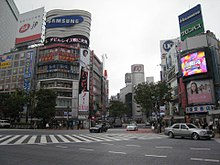Shibuya-kei
| Shibuya-kei | |
|---|---|
 Shibuya Crossing, 2007 | |
| Native name | 渋谷系 |
| Stylistic origins | |
| Cultural origins | 1990s, Shibuya, Tokyo, Japan |
| Fusion genres | |
| Akishibu-kei | |
| Other topics | |
Shibuya-kei (Japanese: 渋谷系, lit. "Shibuya style") is a microgenre[7] of pop music[1] or a general aesthetic[8] that flourished in Japan in the mid-to-late 1990s.[3] The music genre is distinguished by a "cut-and-paste" approach that was inspired by the kitsch, fusion, and artifice from certain music styles of the past.[9] The most common reference points were 1960s culture and Western pop music,[1] especially the work of Burt Bacharach, Brian Wilson, Phil Spector, and Serge Gainsbourg.[10]
Shibuya-kei first emerged as retail music from the
Overseas, fans of Shibuya-kei were typically
Background and influences
The term "Shibuya-kei" comes from
The upper middle-class, privately educated rich kids who frequented these [Shibuya record] stores bought loads of imported records from the UK and esoteric reissues of all kinds, then created music that was a portrait of themselves as exquisitely discerning consumers.
At the time, Shibuya was an epicenter for
Shibuya in the '90s is just like
Haight-Ashbury in the '60s. The young people there are always thinking about how to be cool.
Musicologist Mori Yoshitaka writes that popular groups from the area responded with their "eclectically fashionable hybrid music influenced by different musical resources from around the world in a way that might be identified as
Specific touchstones include the French
Development and popularity
After Oyamada went solo, he became one of the biggest Shibuya-kei successes.
The most prominent Shibuya-kei band was Pizzicato Five, who fused mainstream J-pop with a mix of jazz, soul, and lounge influences, reaching a commercial peak with Made in USA (1994).[14] As the style's popularity increased at end of the 1990s, the term began to be applied to many bands whose musical stylings reflected a more mainstream sensibility. Although some artists rejected or resisted being categorized as "Shibuya-kei," the name ultimately stuck, as the style was favored by local businesses, including Shibuya Center Street's HMV Shibuya, which sold Shibuya-kei records in its traditional Japanese music section. Increasingly, musicians outside Japan—including Momus, La Casa Azul, Dimitri from Paris, Ursula 1000, Nicola Conte, Natural Calamity, and Phofo—are labeled Shibuya-kei.[citation needed] South Korean bands such as Clazziquai Project, Casker, and Humming Urban Stereo have been said to represent "a Korean neo-Shibuya-kei movement".[24]
Shibuya-kei's prominence declined after its principal players began moving into other music styles.[25] Momus said in a 2015 interview that the subculture had more to do with the area itself, which he called "an overblown shopping district".[26]
See also
Notes
- ^ Particularly "Yume Miru Shanson Ningyō", the Japanese version of the France Gall big hit Poupée de cire, poupée de son,[citation needed]
- ^ Like Shibuya-kei, chamber pop foregrounded instruments like strings and horns in its arrangements.[20] AllMusic notes that although chamber pop was "inspired in part by the lounge-music revival", there was a "complete absence of irony or kitsch".[21]
References
- ^ a b c d e f Anon. (n.d.). "Shibuya-Kei". AllMusic.
- ^ a b c d e f Reynolds 2011, p. 168.
- ^ a b c d e Ohanesian, Liz (April 13, 2011). "Japanese Indie Pop: The Beginner's Guide to Shibuya-Kei". LA Weekly.
- ^ 第14回 ─ シティー・ポップ [No. 14 ─ City Pop] (in Japanese). bounce.com. 2003-05-29. Archived from the original on 2007-08-24. Retrieved 2008-11-17.
- ^ Observer.
- ^ a b c d e Martin, Ian (August 28, 2013). "Twenty years ago, Cornelius releases the track that defined Shibuya-kei". The Japan Times.
- ^ "Singles Club: The revolution will not be televised, it'll be robotized". Factmag. August 28, 2018. Retrieved September 27, 2018.
- ^ a b McKnight 2009, p. 451.
- ^ a b Tonelli 2004, p. 4.
- ^ a b Lindsay, Cam (4 August 2016). "Return to the Planet of Cornelius". Vice. Retrieved 17 April 2020.
- ^ a b c d Yoshitaka 2009, p. 225.
- ^ Onishi 1998, p. 482, coined after an HMV Shibuya J-pop display; McKnight 2009, p. 451, HMV Shibuya's J-pop corner opened in 1991
- ^ a b c Reynolds 2011, p. 166.
- ^ a b Alston, Joshua (June 1, 2015). "Pizzicato Five stripped disco to its barest essentials and turned it Japanese". The A.V. Club.
- ^ Onishi 1998, p. 482.
- ^ a b Walters, Barry (November 6, 2014). "The Roots of Shibuya-Kei". Red Bull Music Academy.
- ^ a b Reynolds 2011.
- ^ Evans, Christopher. "Louis Philippe". AllMusic.
- ^ a b c Hadfield, James (July 24, 2016). "Keigo Oyamada sees U.S. 'Fantasma' tour as a good warm-up to new Cornelius material". The Japan Times.
- ^ a b Tonelli 2004, p. 3.
- ^ "Chamber pop". AllMusic.
- ^ a b Reynolds 2011, p. 169.
- ^ Reynolds 2011, p. 170.
- ^ Shin, Hyunjoon; Roberts, Martin (January 2013). East Asian popular music and its (dis)contents. Cambridge University Press. pp. 111–123.
- ^ Michael, Patrick St. (June 11, 2016). "Cornelius: Fantasma Album Review". Pitchfork.
- ^ Fisher, Devon (10 March 2015). "Momus honors music's eccentrics on 'Turpsycore'". The Japan Times. Retrieved 17 April 2020.
Works cited
- McKnight, Anne (2009). "Shibuya-Kei". The Encyclopedia of Contemporary Japanese Culture. Taylor & Francis. ISBN 978-0-415-48152-6.
- Onishi, Koji (1998). "Shibuya-Kei (Shibuya Sound) and globalization". In Mitsui, Tōru (ed.). Popular Music: Intercultural Interpretations. Graduate Program in Music, Kanazawa University. ISBN 978-4-9980684-1-9.
- ISBN 978-1-4299-6858-4.
- Tonelli, Christopher (2004). Shibuya-kei? O-kei Desu!: Postmodernism, Resistance, and Tokyo Indie Culture. University of California, San Diego.
- Yoshitaka, Mori (2009). "Reconsidering Cultural Hybridities". In Berry, Chris; Liscutin, Nicola; Mackintosh, Jonathan D. (eds.). Cultural Studies and Cultural Industries in Northeast Asia: What a Difference a Region Makes. Hong Kong University Press. ISBN 978-962-209-975-3.
External links
- Keikaku - Independent and little known Japanese Artist profiles, reviews, interviews and articles in English.
- Shibuya-kei on CDJournal.com (in Japanese)

